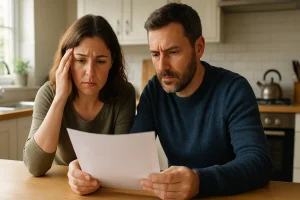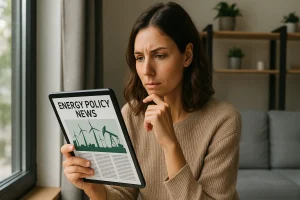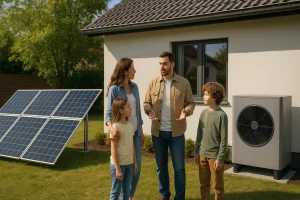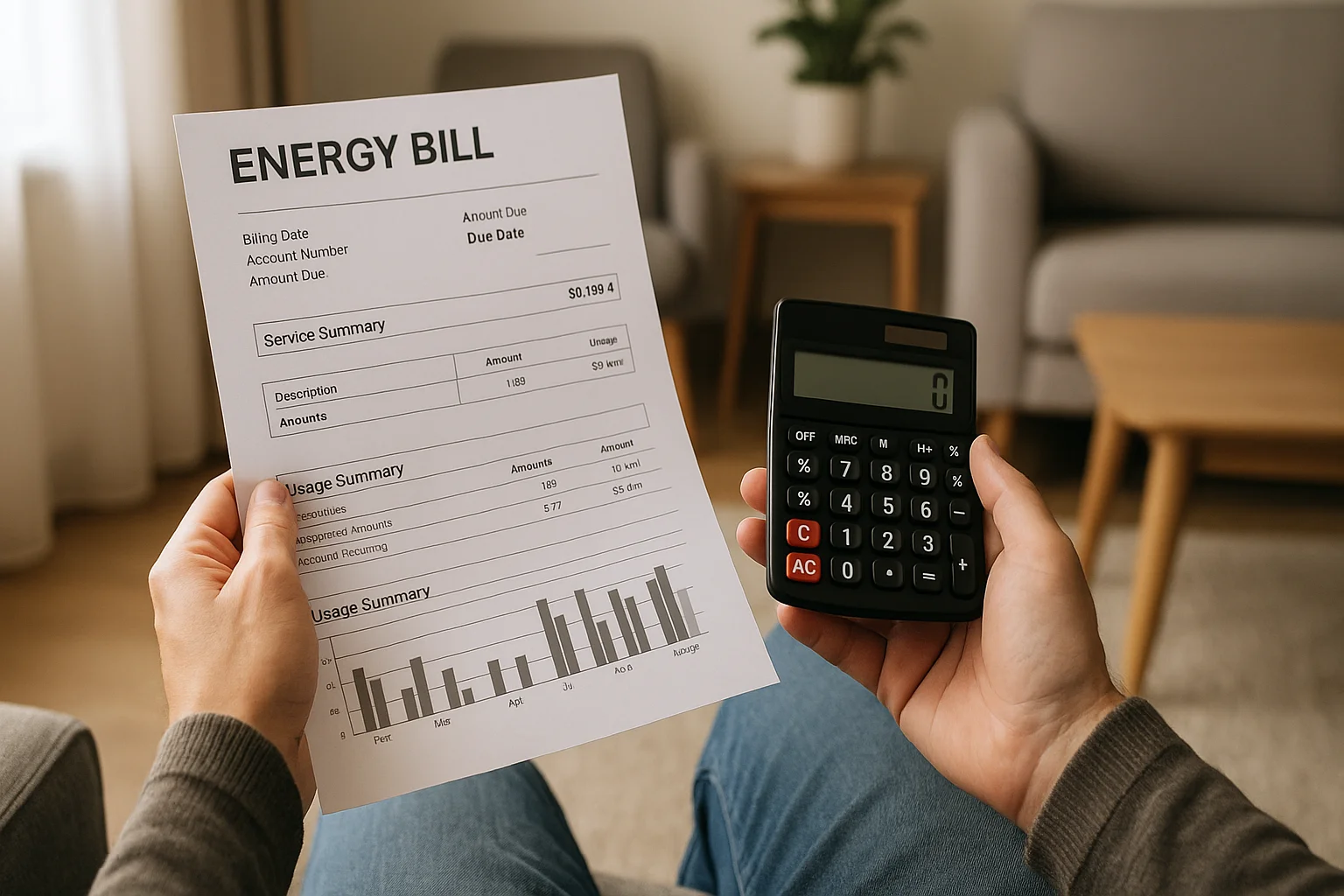Last Updated on: 5th November 2025, 08:26 am
Have you ever looked at your energy bill and wondered why there’s a VAT charge and how much of it is actually necessary? Understanding VAT on energy bills in the UK is more important than ever, especially in today’s climate of rising energy costs and complex tax proposals.
With millions of UK households feeling the pressure of high utility charges, many are now questioning the fairness and structure of VAT applied to domestic and business energy use.
The standard VAT rate might seem straightforward at first glance, but hidden nuances could mean you’re paying more than you need to. Whether you’re a homeowner, tenant, business owner, or charity, knowing your VAT rights can lead to significant savings.
In this guide, you’ll learn how VAT is applied to gas and electricity, who qualifies for reduced rates, and how government proposals might affect your future bills.
What Is the Current VAT Rate on Energy Bills in the UK?

In the UK, the Value Added Tax (VAT) applied to energy bills depends on the nature of usage. There are two main VAT rates that households and businesses encounter, the standard rate of 20% and the reduced rate of 5%.
For domestic use, such as energy used in houses, flats, and even caravans or houseboats, the VAT rate is 5%. This also extends to various types of residential accommodation, including children’s homes, monasteries, and university halls.
However, businesses are generally charged 20% VAT on energy bills. The only exceptions are businesses that use very little energy or are registered charities using energy for non-business purposes.
Key points:
- Domestic use = 5% VAT
- Business use = 20% VAT
- Reduced rate applies to certain cases where energy usage is minimal
- VAT applies whether your bill is metered or estimated
- VAT is also added to charges like standing fees and meter rentals
Additionally, if a business operates from a home setting, the energy used for business purposes is subject to 20% VAT, while domestic energy use remains at 5%.
Understanding these distinctions is essential to make sure you’re paying the correct rate and not being overcharged on your energy bills.
Who Qualifies for the Reduced 5% VAT Rate?
The reduced 5% VAT rate on energy bills is meant to support households and qualifying organisations. While most domestic users benefit automatically, some businesses and special cases may also qualify under specific conditions.
Eligibility includes:
- Residential households: The reduced rate is automatically applied to all domestic properties.
- Charities: If the energy is used exclusively for non-business activities, they qualify for the reduced rate.
- Low usage businesses: If your business uses energy within “de minimis” limits, you may be eligible.
- Mixed-use properties: Businesses run from home may benefit from a partial reduction on the domestic portion of usage.
To claim the reduced rate where it’s not automatically applied, you’ll need to contact your energy supplier. It’s your responsibility to prove your eligibility.
Usually, this is done through a VAT declaration form confirming your type of energy use. Always check your energy bill to ensure the correct VAT rate is being applied.
What Counts as “Low Usage” for VAT Purposes?
HMRC allows certain business customers to qualify for the 5% VAT rate if they consume energy below set limits. This is commonly referred to as the “de minimis” level.
If your energy use falls under these thresholds, you may be charged the reduced VAT rate even if you’re not a domestic user.
Defined small quantities include:
- Electricity: Less than 33 kilowatt-hours (kWh) per day or 1,000 kWh per month
- Gas: Less than 145 kWh per day or 4,397 kWh per month
Here’s a breakdown in table format:
| Energy Type | Daily Threshold | Monthly Threshold |
| Electricity | 33 kWh | 1,000 kWh |
| Gas | 145 kWh | 4,397 kWh |
Even if you occasionally exceed these thresholds, as long as the average remains under the specified limits, you can still qualify.
Bills are typically assessed on a monthly average, whether based on actual or estimated meter readings. Be sure to confirm your usage with your supplier if you think you qualify.
Can You Claim a Refund if You’ve Been Overcharged VAT?

If you’ve been charged 20% VAT on your energy bill but believe you qualify for the reduced 5%, you may be able to request a refund from your supplier. Taking a few simple steps can help you correct the rate and potentially recover overpaid VAT.
Steps to Check Your Bill
First, examine your latest energy bill and look for the VAT section. Most suppliers include a detailed breakdown where you can see the applied VAT rate and the portion of your bill it’s calculated on.
If you notice a 20% charge on what should be domestic use or low-usage business energy, this could be a mistake.
Check that:
- The correct usage type (domestic vs business) is listed
- Your usage levels fall within the small quantity limits
- The VAT rate matches your entitlement
How to Contact Your Supplier?
Contact your energy supplier’s customer service team directly. They’ll usually have a specific department handling VAT queries.
Provide them with:
- Your recent energy bills
- An explanation of why you believe the 5% VAT rate applies
- Any documentation proving your eligibility (charity certificate, usage logs, etc.)
Make sure to follow up via email to have a written record of your request.
VAT Declaration Form
Suppliers often require a VAT declaration form to process your refund. This form allows you to confirm your energy usage category and your eligibility for a reduced rate.
Once submitted and approved, the supplier may adjust future bills and offer a credit or refund for the overpaid amount. Always retain a copy for your records.
Are There Any Other Charges That Are VAT-Reduced?
In addition to the energy supply itself, several associated charges are also eligible for the reduced 5% VAT rate if the main supply is reduced-rated. This applies whether your energy is metered or estimated.
Reduced-rated charges include:
- Standing charges from energy suppliers
- Disconnection and reconnection service charges
- Installation or rental of meters
- Removal of damaged coins or tokens from coin-operated meters
These charges are treated as part of the energy supply and therefore inherit the same VAT rate. If your energy is for domestic use or meets low usage thresholds, these fees will also carry the 5% rate.
Supplies of energy to tenants, especially in accommodation provided by local authorities, are also VAT-free when they are part of a statutory obligation. In such cases, the supply is outside the scope of VAT entirely.
Landlords providing heated or cooled accommodation with energy bundled into rent may not charge VAT either. Understanding these exceptions can help you monitor and question unexpected VAT fees on your bill.
What Is the Government Proposing About VAT on Energy Bills?

The UK government, under the current chancellor, Rachel Reeves, is considering scrapping the 5% VAT rate on electricity bills entirely. This proposal aims to reduce household energy costs and respond to the ongoing cost-of-living crisis.
The idea is popular for its simplicity and ease of implementation. It could provide savings of around £86 annually per household, based on data from charity Nesta. However, this cut would cost the treasury an estimated £2.5 billion each year.
The government’s rationale is rooted in offering immediate relief to voters while attempting to counter the rise of opposition parties promising similar financial relief strategies. However, this plan is still under discussion and forms part of a broader energy strategy to be finalised in upcoming fiscal policies.
Though popular in theory, the VAT removal proposal may have complex consequences for taxation fairness, environmental policy, and economic planning. It’s important to stay updated as these plans could shift with changing political and fiscal priorities.
Why Are Experts Warning Against Cutting VAT on Electricity?
Many economists and environmental experts have criticised the plan to cut the 5% VAT on electricity bills. Their primary concern is that such a move could disproportionately benefit wealthier households, who typically consume more electricity in larger homes.
Critics argue that the cut would be a regressive measure, meaning those with higher energy consumption would receive the largest financial benefits, while lower-income households might see relatively smaller savings. As a result, the policy could increase inequality.
Environmental groups are also worried that removing VAT could encourage more electricity use, undermining the UK’s net-zero climate commitments. Some even believe that this policy could jeopardise ongoing discussions with the EU, which mandates a minimum 5% VAT on energy supplies.
Rather than blanket VAT cuts, experts suggest better-targeted solutions that ensure aid reaches those most in need. The consensus among critics is that a VAT reduction, while easy to implement, may not be the wisest choice economically or environmentally.
What Alternatives to VAT Cuts Are Being Considered?
Instead of scrapping VAT on electricity bills, the UK government is exploring other options that might provide more targeted and sustainable relief.
One major alternative is removing green levies from electricity bills, which could reduce energy costs by shifting subsidy costs to taxpayers instead of consumers.
This method would help reduce household bills without encouraging excessive energy use. It would also maintain environmental funding by allocating it more equitably through taxation based on income, not usage.
Another idea is to reallocate remaining levies from electricity to gas, making it cheaper for households to switch to climate-friendly alternatives like heat pumps. This supports the UK’s net-zero goals without abandoning green initiatives.
Additionally, the government could revisit the £400 rebate strategy used in 2022, offering direct support to all households. While effective, critics say this approach could be expensive and hard to manage long-term.
These options present ways to lower bills while still preserving both environmental and fiscal balance, unlike the broad VAT cut approach.
How Does VAT on Energy Bills Impact the UK’s Climate Goals?

The current structure of VAT on energy bills plays a role in influencing household energy behaviour and, by extension, the UK’s climate policies. Lowering or removing VAT from electricity could make energy appear cheaper, leading to increased consumption.
Environmental groups and advisors have raised concerns that such incentives would delay the country’s transition to greener energy systems. Encouraging more use of electricity without parallel investments in energy efficiency and renewables could undermine decarbonisation efforts.
Experts from organisations like Nesta and the Climate Change Committee recommend shifting levies from electricity to gas, making electricity the more affordable and environmentally friendly choice. This change would also support the adoption of heat pumps over gas boilers.
Ultimately, VAT policy must align with broader sustainability goals. Any tax adjustment that promotes energy consumption without parallel environmental safeguards risks slowing progress toward the UK’s climate targets. Therefore, VAT changes must be weighed not just economically, but environmentally as well.
What Should You Do to Ensure You’re Paying the Correct VAT?
Making sure you’re charged the correct VAT rate on your energy bill can help prevent overpayments and ensure compliance with tax regulations. Whether you’re a household, charity, or small business, reviewing your energy use and charges regularly is essential.
To ensure accuracy:
- Check the VAT rate on your bill. Domestic use should be charged at 5%.
- Track your energy usage to see if it falls within the low-usage thresholds.
- Assess your property’s usage type, home, business, or mixed-use.
- Confirm charges on standing fees and meter-related services are at the correct rate.
If you spot discrepancies:
- Contact your supplier and explain why you believe the rate is incorrect.
- Request a VAT declaration form if you’re eligible for the reduced rate but were charged 20%.
- Retain all correspondence and documentation for your records.
Keeping a close eye on these details ensures that you’re not losing money due to avoidable VAT mischarges. Staying informed empowers you to manage your energy bills more effectively.
Conclusion
VAT on energy bills might seem like a small detail on your utility statement, but it carries significant financial and policy implications. As we’ve explored, understanding when the 5% or 20% rate applies can help you save money and avoid overcharges.
For many UK households and charities, knowing the thresholds for reduced VAT and actively checking bills can make a real difference in annual costs.
While the government debates whether to remove VAT entirely or shift levies elsewhere, it’s clear that any decision must balance affordability with climate responsibilities.
As an energy user, staying informed puts you in control. Check your bills, understand your entitlements, and don’t hesitate to reach out to your supplier if something looks wrong. Managing your VAT charges is one more step toward energy efficiency and financial confidence in uncertain times.
FAQs
Can I get a VAT refund if I use less energy at home?
Yes, if you qualify under the low-usage criteria and were charged 20%, you can request a refund from your supplier.
Does working from home affect how much VAT I pay?
Yes, energy used for business purposes from home is charged at 20%, while the domestic portion remains at 5%.
Are charities automatically eligible for the 5% VAT rate?
Charities are eligible only if the energy is used strictly for non-business activities and a VAT declaration is submitted.
How do landlords handle VAT on tenant energy bills?
If energy is included in rent for heated accommodation, it’s often VAT-exempt; metered supplies are charged at 5% if for domestic use.
Are standing charges and meter fees subject to VAT?
Yes, but they inherit the VAT rate of the energy supply. If your energy is charged at 5%, so are these additional charges.
Could VAT be removed completely in the UK?
It’s being considered, but experts warn it could disproportionately benefit wealthier households and harm environmental efforts.
What’s the difference between VAT and green levies on energy?
VAT is a consumption tax, while green levies fund renewable energy schemes and insulation projects. The government is considering adjusting both.




















No Comments
Leave a comment Cancel